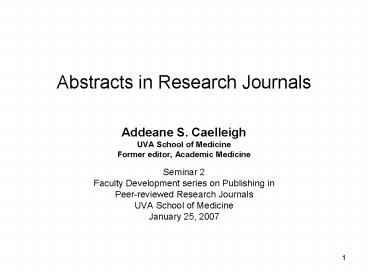Abstracts in Research Journals - PowerPoint PPT Presentation
1 / 29
Title: Abstracts in Research Journals
1
Abstracts in Research Journals
- Addeane S. Caelleigh
- UVA School of Medicine
- Former editor, Academic Medicine
- Seminar 2
- Faculty Development series on Publishing in
- Peer-reviewed Research Journals
- UVA School of Medicine
- January 25, 2007
2
why are abstracts important?
- They are likely the only part of paper that most
readers will look at. - They presents the core of the paper for the
record in databases and secondary collections.
3
- Accurate abstracts are crucial in early stages of
meta-analyses and literature reviews.
4
- All research journals require abstracts.
- Some use the authors abstract.
- Some revise the authors abstract.
- Some write the abstract.
5
- Several efforts to improve abstract during past
30 years - all journals should have abstracts
6
- Abstracts should give full reference citation for
article - originally, to the print edition
- later, to unique ID number for electronic version
7
- Abstracts should be structured like the research
reports they represent. - to make them easier to understand
- to help eliminate inconsistencies between
abstract and text - to make them appropriate for electronic formats
- (more about structured abstracts later)
8
general types of abstracts
- Two major types
- Indicative describes what the article is about
but does not summarize the contents - Informative a summary (abstract) of the
research
9
- Most articles in research journals have
informative abstracts - they give information about the research itself
10
- A few articles (such as literature reviews) have
indicative abstracts - describe the nature of the materials, not the
contents per se
11
- Example of indicative abstract
- This review covers the many different
adverse effects that have been reported for the
drugs most widely used in the treatment of breast
cancer. It considers them as generalized
systemic effects and by body systems. An attempt
has been made to assess their degree of
life-threatening severity and to suggest how
patients can be monitored for their early
detection. - --------------------
- from Huth, EJ, Writing and Publishing in
Medicine, 3rd ed, Baltimore, MD Williams
Wilkins, 1999, p. 137. (Edward Huth, MD, was
editor of the Annals of Internal Medicine
1971-1990.)
12
- Informative abstracts are the familiar abstracts
that explain the research question, methods or
materials, analysis, etc.
13
- Simple structure for an informative abstract
- Introduction
- Materials and Methods
- Results
- Discussion and Conclusion
- (basically, the IRMAD format used for papers)
14
- Common, more detailed structure for an
informative abstract - Background
- Objective
- Design
- Setting
- Participants
- Measurements
- Results
- Conclusions
15
- Typical structure for a review article
- Objective
- Data Sources
- Study Selection
- Data Extraction
- Data Synthesis
- Conclusions
16
- Different branches of science have different
structures, but they all boil down to - (Purpose/Question/Introduction)
- Method
- Results
- Conclusion
17
movement to structured abstract
- Movement to the structured abstract in
biomedical research journals - discussions and proposals throughout the 1980s
- one of first standards of the ICMJE was that
journals should use structured abstracts
(International Committee of Medical Journal
Editors)
18
- Research since the mid-1990s on the use and
effect of the structured abstract - SAs usually contain more information
- are easier to read
- easier to search, maybe (studies dont agree)
19
- may be easier to recall
- generally welcomed by readers and authors
20
- But ..
- SAs usually take more space
- sometimes have confusing layouts
- may have the same kinds of omissions and
distortions as traditional abstracts - ----------------------------------
- Findings from Hartley J. 2004. Current findings
from research on structured abstracts, J Med Lib
Assoc 92(3, July)368-371.
21
tips for writing better abstracts
- write abstract before writing the paper or after?
- probably should do both serves different
purposes at different times in process
22
- In starting, keep in mind
- What is the message?
- Why is it important?
- To whom is it important?
23
- Writing the abstract early helps author
organize thinking - see the big picture
- state the most important issues and points
- understand how the pieces fit together
24
- While writing the paper, check the early
abstract - Are you doing what the abstract said you would
do? - Do you still think the same way about the most
important points and central message?
25
- When paper is finished, write the abstract based
on the final text - Compare it with the early abstract(s)
- Has any content changed? Why?
- Has emphasis shifted? Why?
- Which best expresses what you intended to say?
- Which best expresses what the paper now says?
26
- Write the final abstract in the length
required/allowed. - Also, understand the length constraints of the
most important databasesthe abstract needs to
cover all essential points within that length
regardless of what the journal allows. - For example, Medline cuts off all abstracts at
250 words.
27
- Be sure that there are no inconsistencies between
the abstract and the text of the paper.
28
Wrap up
- Abstracts are extremely important.
- It is important to follow journals guidelines/
requirements. - All the crucial elements, central points must be
in the abstract. - Eliminate the common flaws found in other
peoples abstractsthink like a reader.
29
- contact information
- Addeane S. CaelleighUniversity of Virginia
School of Medicine - asc8f_at_virginia.edu434-982-6571































